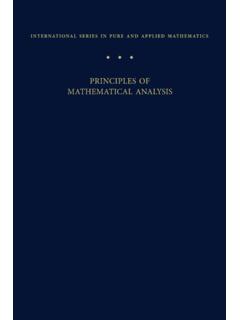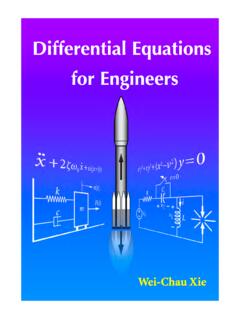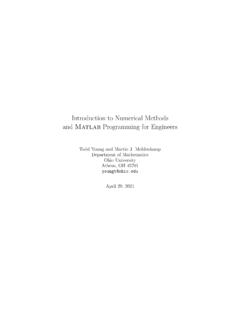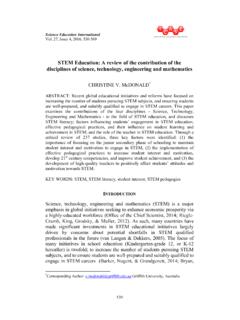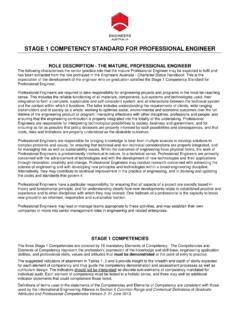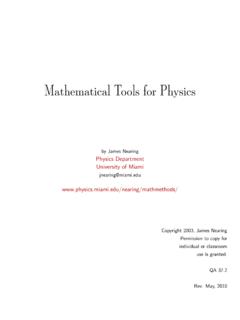Transcription of TABLE OF INVERSE LAPLACE TRANSFORMS
1 TABLE OF INVERSE LAPLACE TRANSFORMS . F(s). 1. 2. 3. 4. 5. 6. 7. 8. 9. 10. PROPERTIES OF THE LAPLACE TRANSFORM: 1. 2. 3. 4. 5. 6. 7. 8. 9. 10. 11. 12. 13. AN INTRODUCTION TO. DIFFERENTIAL. EQUATIONS. AND THEIR APPLICATIONS. AN INTRODUCTION TO. DIFFERENTIAL. EQUATIONS. AND THEIR APPLICATIONS. STANLEY J. FARLOW. University of Maine DOVER PUBLICATIONS, INC. Mineola, New York Copyright Copyright 1994 by Stanley J. Farlow All rights reserved. Bibliographical Note This Dover edition, first published in 2006, is an unabridged republication of the work originally published by McGraw-Hill, Inc.
2 , New York, in 1994. All color materials have been reprinted in black and white. International Standard Book Number ISBN-13: 978-0-486-44595-3. ISBN-10: 0-486-44595-X. Manufactured in the United States by Courier Corporation 44595X03. ABOUT THE AUTHOR. Stanley J. Farlow has academic degrees from Iowa State University, the University of Iowa, and Oregon State University. He is a former Lieutenant Commander and Public Health Service Fellow who served for several years as a computer analyst at the National Institutes of Health in Bethesda, Maryland.
3 In 1968 he joined the faculty of the University of Maine, where he is currently Professor of mathematics . He is also the author of Partial Differential Equations for Scientists and Engineers, (currently being published by Dover Publications, Inc.), Finite mathematics (McGraw-Hill, 1988, 1994), applied mathematics (McGraw-Hill, 1988), Introduction to Calculus (McGraw-Hill, 1990), and Calculus and Its Applications (McGraw-Hill, 1990). He has also edited The GMDH Method: Self- Organizing methods in Modeling (Marcel Dekker, 1984).
4 To Dorothy and Susan CONTENTS. Preface CHAPTER 1 INTRODUCTION TO DIFFERENTIAL. EQUATIONS. Prologue Basic Definitions and Concepts Some Basic Theory CHAPTER 2 FIRST-ORDER DIFFERENTIAL EQUATIONS. First-Order Linear Equations Separable Equations Growth and Decay Phenomena Mixing Phenomena Cooling and Heating Phenomena More Applications Direction Field and Euler's Method Numerical methods CHAPTER 3 SECOND-ORDER LINEAR EQUATIONS. to Second-Order Linear Equations Solutions of the Homogeneous Equation of Order Equations with Constant Coefficients: Real Roots Equations with Constant Coefficients: Complex Roots Equations Nonhomogeneous Equations: Method of Undetermined Coefficients Nonhomogeneous Equations: Method of Variation of Parameters Systems and Simple Harmonic Motion Damped Vibrations Vibrations to Higher-Order Equations (Optional).
5 CHAPTER 4 SERIES SOLUTIONS. : A Review of Power Series Series Expansions about Ordinary Points: Part I. Series Expansions about Ordinary Points: Part II. Solutions about Singular Points: The Method of Frobenius Functions CHAPTER 5 THE LAPLACE TRANSFORM. of the LAPLACE Transform of the LAPLACE Transform INVERSE LAPLACE Transform Problems Functions and Delayed Functions Equations with Discontinuous Forcing Functions Forcing Functions Convolution Integral CHAPTER 6 SYSTEMS OF DIFFERENTIAL EQUATIONS. to Linear Systems: The Method of Elimination of Matrices Theory of First-Order Linear Systems Linear Systems with Real Eigenvalues Linear Systems with Complex Eigenvalues Linear Systems Linear Systems: LAPLACE Transform (Optional).
6 Of Linear Systems Solution of Systems of Differential Equations CHAPTER 7 DIFFERENCE EQUATIONS. to Difference Equations Equations Equations of Difference Equations Logistic Equation and the Path to Chaos Systems: Julia Sets and the Mandelbrot Set (Optional). CHAPTER 8 NONLINEAR DIFFERENTIAL EQUATIONS AND. CHAOS. Plane Analysis of Autonomous Systems Points and Stability for Linear Systems : Almost Linear Systems , Poincare Sections and Strange Attractors CHAPTER 9 PARTIAL DIFFERENTIAL EQUATIONS. Series Sine and Cosine Series to Partial Differential Equations Vibrating String: Separation of Variables Interpretation of the Vibrating String Heat Equation and Separation of Variables 's Equation Inside a Circle Appendix: Complex Numbers and Complex-Valued Functions Answers to Problems Index PREFACE.
7 An Introduction to Differential Equations and Their Applications is intended for use in a beginning one-semester course in differential equations. It is designed for students in pure and applied mathematics who have a working knowledge of algebra, trigonometry, and elementary calculus. The main feature of this book lies in its exposition. The explanations of ideas and concepts are given fully and simply in a language that is direct and almost conversational in tone. I hope I have written a text in differential equations that is more easily read than most, and that both your task and that of your students will be helped.
8 Perhaps in no other college mathematics course is the interaction between mathematics and the physical sciences more evident than in differential equations, and for that reason I have tried to exploit the reader's physical and geometric intuition. At one extreme, it is possible to approach the subject on a highly rigorous lemma-theoremcorollary level, which, for a course like differential equations, squeezes out the lifeblood of the subject, leaving the student with very little understanding of how differential equations interact with the real world.
9 At the other extreme, it is possible to wave away all the mathematical subtleties until neither the student nor the instructor knows what's going on. The goal of this book is to balance mathematical rigor with intuitive thinking. FEATURES OF THE BOOK. Chaotic Dynamical Systems This book covers the standard material taught in beginning differential equations courses, with the exception of Chapters 7 and 8, where I have included optional sections relating to chaotic dynamical systems. The period- doubling phenomenon of the logistic equation is introduced in Section and Julia sets and the Mandelbrot set are introduced in Section Then, in Section , the chaotic behavior of certain nonlinear differential equations is summarized, and the Poincare section and strange attractors are defined and discussed.
10 Problem Sets One of the most important aspects of any mathematics text is the problem sets. The problems in this book have been accumulated over 25 years of teaching differential equations and have been written in a style that, I hope, will pique the student's interest. Because not all material can or should be included in a beginning textbook, some problems are placed within the problem sets that serve to introduce additional new topics. Often a brief paragraph is added to define relevant terms. These problems can be used to provide extra material for special students or to introduce new material the instructor may wish to discuss.
